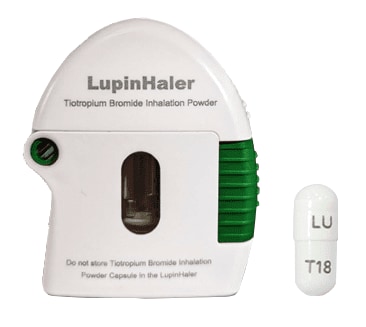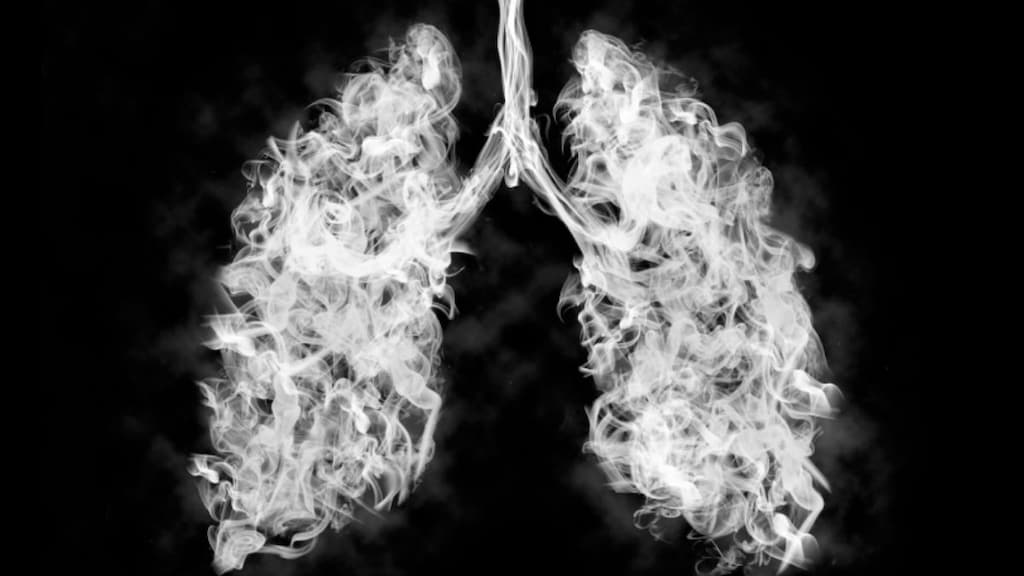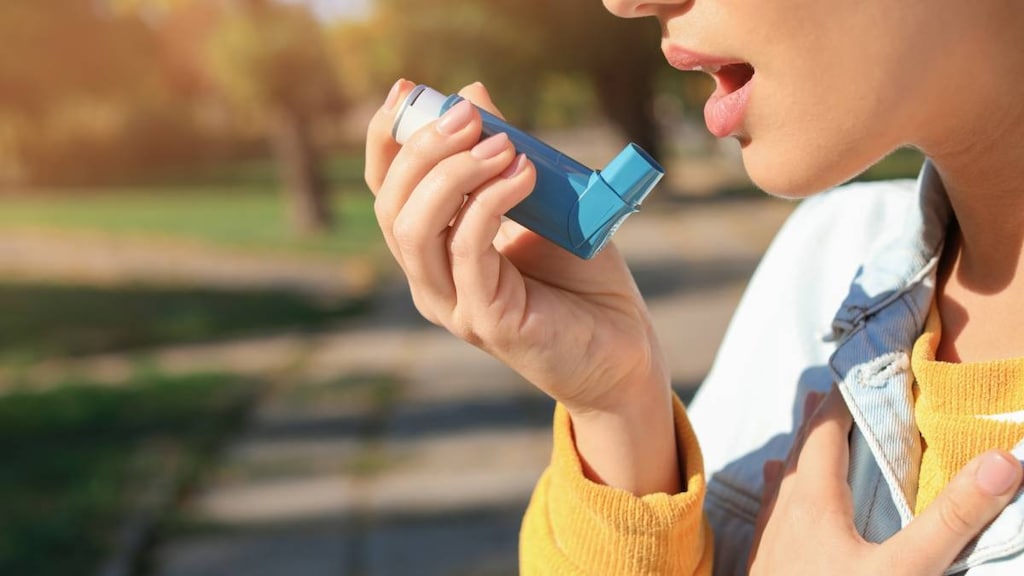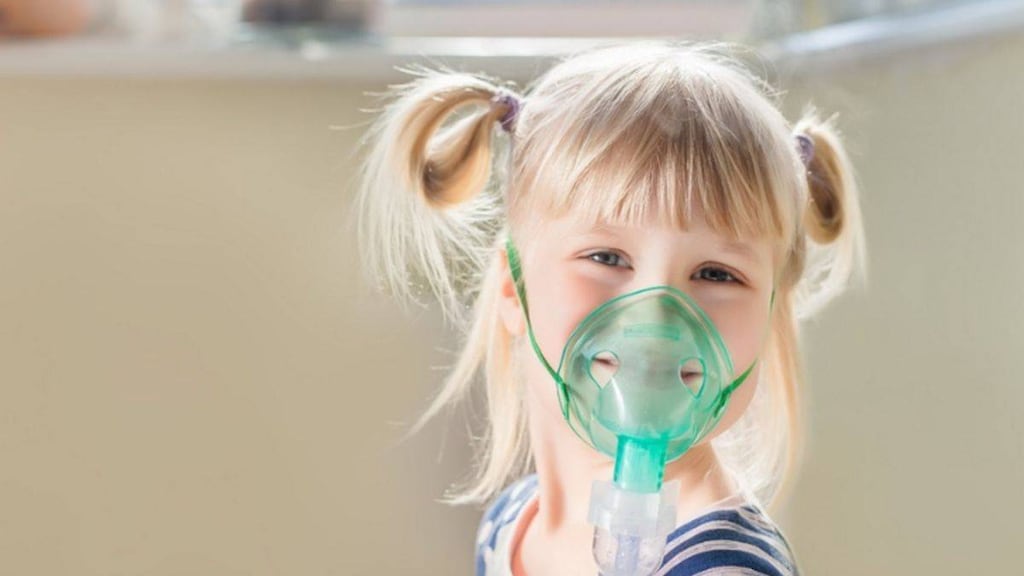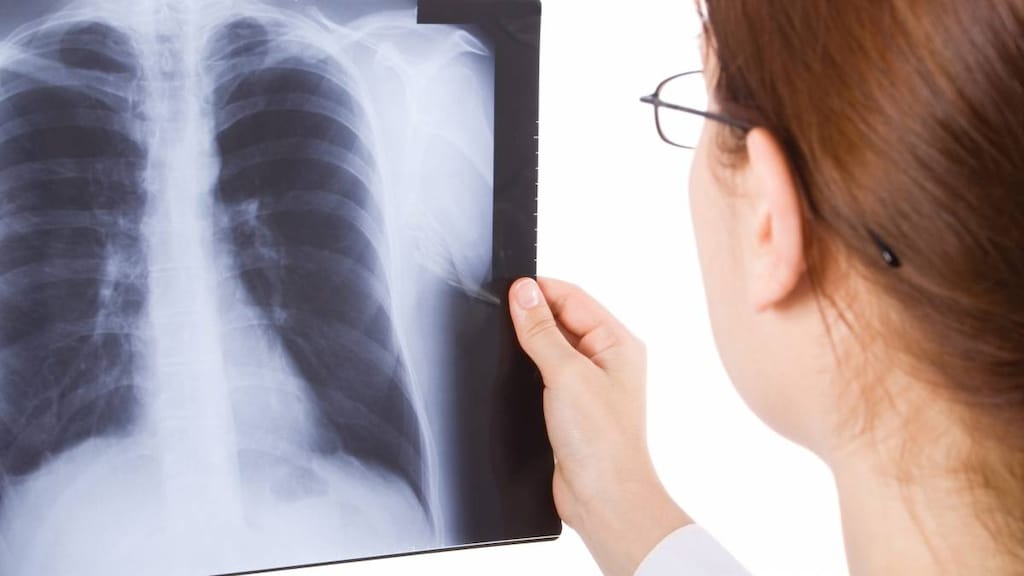Dosage Forms
Excipient information presented when available (limited, particularly for generics); consult specific product labeling.
Aerosol Solution, Inhalation:
Spiriva Respimat: 1.25 mcg/actuation (4 g); 2.5 mcg/actuation (4 g) [contains benzalkonium chloride, disodium edta]
Capsule, Inhalation:
Spiriva HandiHaler: 18 mcg [contains milk protein]
Pharmacology
Mechanism of Action
Competitively and reversibly inhibits the action of acetylcholine at type 3 muscarinic (M3) receptors in bronchial smooth muscle causing bronchodilation
Pharmacokinetics/Pharmacodynamics
Absorption
Poorly absorbed from GI tract, systemic absorption may occur from lung.
Distribution
Vd: 32 L/kg
Metabolism
Hepatic (minimal), via CYP2D6 and CYP3A4
Excretion
Urine (7% of an inhaled dose [dry powder inhaler]; 18.6% of an inhaled dose [COPD] or 12.8% [asthma] [soft-mist inhaler])
Time to Peak
Dry powder inhaler: Plasma: 7 minutes (following inhalation)
Soft-mist inhaler: Plasma: 5 to 7 minutes (following inhalation)
Half-Life Elimination
Dry powder inhaler: COPD: ~25 hours
Soft-mist inhaler: Asthma: 44 hours; COPD: 25 hours
Protein Binding
72%
Use in Specific Populations
Special Populations: Renal Function Impairment
Reduced clearance and increased plasma concentrations may occur.
Special Populations: Elderly
Reduced clearance may occur.
Use: Labeled Indications
Asthma (Spiriva Respimat only): Maintenance treatment of asthma in patients ≥6 years.
Chronic obstructive pulmonary disease: Maintenance treatment of bronchospasm associated with chronic obstructive pulmonary disease (COPD), including chronic bronchitis and emphysema; reduction of COPD exacerbations.
Limitations of use: Not indicated for the relief of acute bronchospasm.
Contraindications
Hypersensitivity to ipratropium, tiotropium, or any component of the formulation
Canadian labeling: Additional contraindications (not in US labeling): Hypersensitivity to atropine or its derivatives
Dosage and Administration
Dosing: Adult
Asthma: Oral inhalation: Spiriva Respimat (1.25 mcg/actuation): Soft-mist inhaler: Two inhalations (2.5 mcg) once daily (maximum: 2 inhalations per 24 hours). Note: Maximum benefits may take up to 4 to 8 weeks of dosing. In clinical trials, doses >2.5 mcg/day were not associated with greater efficacy in FEV1 response.
COPD: Oral inhalation:
Spiriva HandiHaler: Dry powder inhaler: Contents of 1 capsule (18 mcg) inhaled once daily using HandiHaler device. Note: To ensure drug delivery, the contents of each capsule should be inhaled twice.
Spiriva Respimat (2.5 mcg/actuation): Soft-mist inhaler: Two inhalations (5 mcg) once daily (maximum: 2 inhalations per 24 hours).
Dosing: Geriatric
Refer to adult dosing.
Dosing: Pediatric
Asthma: Children ≥6 years of age and Adolescents: Inhalation: Spiriva Respimat (1.25 mcg/actuation): Soft-mist inhaler: Refer to adult dosing.
Asthma, severe symptomatic (off-label use): Children ≥6 to 11 years of age: Inhalation: Spiriva Respimat (2.5 mcg/actuation): Soft-mist inhaler: Two inhalations (5 mcg) once daily as add-on therapy to inhaled corticosteroids and other maintenance therapies (Szefler 2017).
Administration
For oral inhalation only.
Spiriva HandiHaler: Dry powder inhaler: Do not swallow capsule. Administer at the same time each day. Do not remove capsule from blister until immediately before use. Place capsule in the center chamber of the HandiHaler Inhaler. Must only use the HandiHaler Inhaler. Close mouthpiece firmly until a click is heard, leaving dustcap open. The capsule is pierced by pressing and releasing the green piercing button on the side of the HandiHaler device. Exhale fully. Close lips tightly around mouthpiece; do not exhale into inhaler. Tilt head slightly back and inhale (rapidly, steadily, and deeply); the capsule vibration (rattle) may be heard within the device. Hold breath for a few seconds then repeat procedure using the same tiotropium capsule. Throw away empty capsule by tipping into a trash can without touching it; do not leave in inhaler. Keep capsules and inhaler dry. Discard any capsules that are exposed to air and not used immediately.
Spiriva Respimat: Soft-mist inhaler: Prior to first use, insert cartridge into the inhaler and prime the unit by actuating the inhaler toward the ground until an aerosol cloud is visible; repeat three more times and then the unit is primed and ready for use. If not used for more than 3 days, actuate the inhaler once to prepare the inhaler for use. If not used for more than 21 days, actuate the inhaler until an aerosol cloud is visible and then repeat the process three more times to prepare the inhaler for use.
Storage
Spiriva HandiHaler: Store at 25°C (77°F); excursions permitted between 15°C and 30°C (59°F and 86°F). Avoid extreme temperatures and moisture. Do not store capsules in HandiHaler device. Store capsules in the blister pack and only remove immediately before use. Once protective foil is peeled back and/or removed, the capsule should be used immediately; if capsule is not used immediately it should be discarded.
Spiriva Respimat: Store at 25°C (77°F); excursions are permitted between 15°C and 30°C (59°F and 86°F). Avoid freezing.
Tiotropium Images
Drug Interactions
Acetylcholinesterase Inhibitors: May diminish the therapeutic effect of Anticholinergic Agents. Anticholinergic Agents may diminish the therapeutic effect of Acetylcholinesterase Inhibitors. Monitor therapy
Aclidinium: May enhance the anticholinergic effect of Anticholinergic Agents. Avoid combination
Amantadine: May enhance the anticholinergic effect of Anticholinergic Agents. Monitor therapy
Anticholinergic Agents: May enhance the anticholinergic effect of Tiotropium. Avoid combination
Botulinum Toxin-Containing Products: May enhance the anticholinergic effect of Anticholinergic Agents. Monitor therapy
Cannabinoid-Containing Products: Anticholinergic Agents may enhance the tachycardic effect of Cannabinoid-Containing Products. Exceptions: Cannabidiol. Monitor therapy
Chloral Betaine: May enhance the adverse/toxic effect of Anticholinergic Agents. Monitor therapy
Cimetropium: Anticholinergic Agents may enhance the anticholinergic effect of Cimetropium. Avoid combination
Eluxadoline: Anticholinergic Agents may enhance the constipating effect of Eluxadoline. Avoid combination
Gastrointestinal Agents (Prokinetic): Anticholinergic Agents may diminish the therapeutic effect of Gastrointestinal Agents (Prokinetic). Monitor therapy
Glucagon: Anticholinergic Agents may enhance the adverse/toxic effect of Glucagon. Specifically, the risk of gastrointestinal adverse effects may be increased. Monitor therapy
Glycopyrrolate (Oral Inhalation): Anticholinergic Agents may enhance the anticholinergic effect of Glycopyrrolate (Oral Inhalation). Avoid combination
Glycopyrronium (Topical): May enhance the anticholinergic effect of Anticholinergic Agents. Avoid combination
Ipratropium (Oral Inhalation): May enhance the anticholinergic effect of Anticholinergic Agents. Avoid combination
Itopride: Anticholinergic Agents may diminish the therapeutic effect of Itopride. Monitor therapy
Levosulpiride: Anticholinergic Agents may diminish the therapeutic effect of Levosulpiride. Avoid combination
Loxapine: Agents to Treat Airway Disease may enhance the adverse/toxic effect of Loxapine. More specifically, the use of Agents to Treat Airway Disease is likely a marker of patients who are likely at a greater risk for experiencing significant bronchospasm from use of inhaled loxapine. Management: This is specific to the Adasuve brand of loxapine, which is an inhaled formulation. This does not apply to non-inhaled formulations of loxapine. Avoid combination
Methacholine: Long-acting muscarinic antagonists (LAMAs) may diminish the therapeutic effect of Methacholine. Consider therapy modification
Mianserin: May enhance the anticholinergic effect of Anticholinergic Agents. Monitor therapy
Mirabegron: Anticholinergic Agents may enhance the adverse/toxic effect of Mirabegron. Monitor therapy
Nitroglycerin: Anticholinergic Agents may decrease the absorption of Nitroglycerin. Specifically, anticholinergic agents may decrease the dissolution of sublingual nitroglycerin tablets, possibly impairing or slowing nitroglycerin absorption. Monitor therapy
Opioid Agonists: Anticholinergic Agents may enhance the adverse/toxic effect of Opioid Agonists. Specifically, the risk for constipation and urinary retention may be increased with this combination. Monitor therapy
Oxatomide: May enhance the anticholinergic effect of Anticholinergic Agents. Avoid combination
Potassium Chloride: Anticholinergic Agents may enhance the ulcerogenic effect of Potassium Chloride. Management: Patients on drugs with substantial anticholinergic effects should avoid using any solid oral dosage form of potassium chloride. Avoid combination
Potassium Citrate: Anticholinergic Agents may enhance the ulcerogenic effect of Potassium Citrate. Avoid combination
Pramlintide: May enhance the anticholinergic effect of Anticholinergic Agents. These effects are specific to the GI tract. Consider therapy modification
Ramosetron: Anticholinergic Agents may enhance the constipating effect of Ramosetron. Monitor therapy
Revefenacin: Anticholinergic Agents may enhance the anticholinergic effect of Revefenacin. Avoid combination
Secretin: Anticholinergic Agents may diminish the therapeutic effect of Secretin. Management: Avoid concomitant use of anticholinergic agents and secretin. Discontinue anticholinergic agents at least 5 half-lives prior to administration of secretin. Consider therapy modification
Thiazide and Thiazide-Like Diuretics: Anticholinergic Agents may increase the serum concentration of Thiazide and Thiazide-Like Diuretics. Monitor therapy
Topiramate: Anticholinergic Agents may enhance the adverse/toxic effect of Topiramate. Monitor therapy
Umeclidinium: May enhance the anticholinergic effect of Anticholinergic Agents. Avoid combination
Adverse Reactions
Non-postmarketing incidences listed are for powder for inhalation unless otherwise specified.
>10%:
Gastrointestinal: Xerostomia (powder and solution: 4% to 16%)
Respiratory: Upper respiratory tract infection (41% to 43%), pharyngitis (powder and solution: 7% to 16%), sinusitis (powder and solution: 3% to 11%)
1% to 10%:
Cardiovascular: Chest pain (powder and solution: ≤7%), edema (dependent, 3% to 5%), angina pectoris (1% to 3%; includes exacerbation of angina pectoris), palpitations (powder and solution: ≤3%), hypertension (solution: 1% to 2%)
Central nervous system: Headache (powder and solution: 4% to 6%), depression (≤4%), insomnia (powder and solution: ≤4%), paresthesia (1% to 3%), dizziness (powder and solution: ≤3%), voice disorder (powder and solution: ≤3%)
Dermatologic: Skin rash (powder and solution: 1% to 4%), pruritus (powder and solution: ≤3%)
Endocrine & metabolic: Hypercholesterolemia (1% to 3%), hyperglycemia (1% to 3%)
Gastrointestinal: Abdominal pain (5% to 6%), dyspepsia (1% to 6%), constipation (powder and solution: 1% to 5%), vomiting (1% to 4%), gastrointestinal disease (not otherwise specified; 1% to 3%), gastroesophageal reflux disease (powder and solution: ≤3%), oropharyngeal candidiasis (powder and solution: ≤3%), stomatitis (includes ulcerative stomatitis; powder and solution: ≤3%), diarrhea (solution: 1% to 2%)
Genitourinary: Urinary tract infection (powder and solution: 1% to 7%)
Hypersensitivity: Hypersensitivity reaction (powder and solution: ≤3%)
Infection: Candidiasis (3% to 4%), infection (1% to 4%), herpes zoster (powder and solution: ≤3%)
Neuromuscular & skeletal: Arthralgia (powder and solution: ≤4%), myalgia (4%), arthritis (≥3%), leg pain (1% to 3%), skeletal pain (1% to 3%)
Ophthalmic: Cataract (1% to 3%)
Respiratory: Rhinitis (powder and solution: ≤6%), epistaxis (powder and solution: ≤4%), cough (powder: ≥3%; solution: 1% to 2% ), flu-like symptoms (≥3%), bronchitis (solution: 3%), laryngitis (powder and solution: ≤3%), allergic rhinitis (solution: 1% to 2%)
Miscellaneous: Fever (solution: 1% to 2%)
<1%, postmarketing, and/or case reports: Abnormal hepatic function tests, anaphylaxis, angioedema, application site irritation (powder; includes glossitis, oral mucosa ulcer, pharyngolaryngeal pain), atrial fibrillation, blurred vision, bronchospasm, dehydration, dermal ulcer, dysphagia, dysuria, gingivitis, glaucoma, glossitis, hepatic insufficiency, hoarseness, increased intraocular pressure, intestinal obstruction (includes paralytic ileus), joint swelling, limb pain, muscle spasm, mydriasis (if powder comes in contact with eyes), oropharyngeal pain, paradoxical bronchospasm, skin infection, supraventricular tachycardia, tachycardia, throat irritation, tonsillitis, urinary retention, urticaria, xeroderma
Warnings/Precautions
Concerns related to adverse effects:
- Bronchospasm: Paradoxical bronchospasm may occur with use of inhaled agents; discontinue use and consider other therapy if bronchospasm occurs.
- CNS effects: May cause dizziness and blurred vision; patients must be cautioned about performing tasks that require mental alertness (eg, operating machinery or driving).
- Hypersensitivity reactions: Immediate hypersensitivity reactions (urticaria, angioedema, rash, bronchospasm, anaphylaxis, itching) have been reported. Discontinue immediately if signs/symptoms occur. Use with caution in patients with a history of hypersensitivity to atropine.
Disease-related concerns:
- Glaucoma: May worsen symptoms of narrow-angle glaucoma; use with caution.
- Prostatic hyperplasia/bladder neck obstruction: May worsen the symptoms of prostatic hyperplasia and/or bladder neck obstruction; use with caution.
- Renal impairment: Use with caution in patients with moderate to severe renal impairment (CrCl ≤60 mL/minute); monitor closely for anticholinergic adverse events.
Concurrent drug therapy issues:
- Drug-drug interactions: Potentially significant interactions may exist, requiring dose or frequency adjustment, additional monitoring, and/or selection of alternative therapy. Consult drug interactions database for more detailed information.
Dosage form specific issues:
- Lactose: Capsule for oral inhalation may contain lactose; use with caution in patients with severe milk protein allergy.
Other warnings/precautions:
- Appropriate administration: Not indicated for the initial (rescue) treatment of acute episodes of bronchospasm.
- Appropriate use: Spiriva HandiHaler: The contents of Spiriva capsules are for inhalation only via the HandiHaler device. Capsules should not be swallowed; there have been reports of incorrect administration (swallowing of the capsules).
- Appropriate use: Spiriva Respimat: The contents of Spiriva inhalation spray are for inhalation only via the Respimat inhaler.
- Avoid ocular contact: Avoid inadvertent instillation into the eyes; may dilate pupils and/or cause blurred vision.
Monitoring Parameters
FEV1, peak flow (or other pulmonary function studies); anticholinergic adverse reactions (patients with CrCl ≤50 mL/min); signs and symptoms of narrow angle glaucoma and urinary retention
Pregnancy
Pregnancy Considerations
Adverse events have been observed in animal reproduction studies.
Patient Education
What is this drug used for?
- It is used to treat COPD (chronic obstructive pulmonary disease).
- It is used to treat asthma.
- This drug is not to be used to treat intense flare-ups of shortness of breath. Use a rescue inhaler. Talk with the doctor.
Frequently reported side effects of this drug
- Dry mouth
- Nausea
- Abdominal pain
- Dizziness
- Stuffy nose
- Runny nose
- Sore throat
Other side effects of this drug: Talk with your doctor right away if you have any of these signs of:
- Vision changes
- Eye pain
- Severe eye irritation
- Red eyes
- Seeing halos or bright colors around lights
- Difficult urination
- Painful urination
- Passing a lot of urine
- Change in amount of urine passed
- Chest pain
- Difficulty breathing
- Wheezing
- Cough
- Signs of a significant reaction like wheezing; chest tightness; fever; itching; bad cough; blue skin color; seizures; or swelling of face, lips, tongue, or throat.
Note: This is not a comprehensive list of all side effects. Talk to your doctor if you have questions.
Consumer Information Use and Disclaimer: This information should not be used to decide whether or not to take this medicine or any other medicine. Only the healthcare provider has the knowledge and training to decide which medicines are right for a specific patient. This information does not endorse any medicine as safe, effective, or approved for treating any patient or health condition. This is only a brief summary of general information about this medicine. It does NOT include all information about the possible uses, directions, warnings, precautions, interactions, adverse effects, or risks that may apply to this medicine. This information is not specific medical advice and does not replace information you receive from the healthcare provider. You must talk with the healthcare provider for complete information about the risks and benefits of using this medicine.
